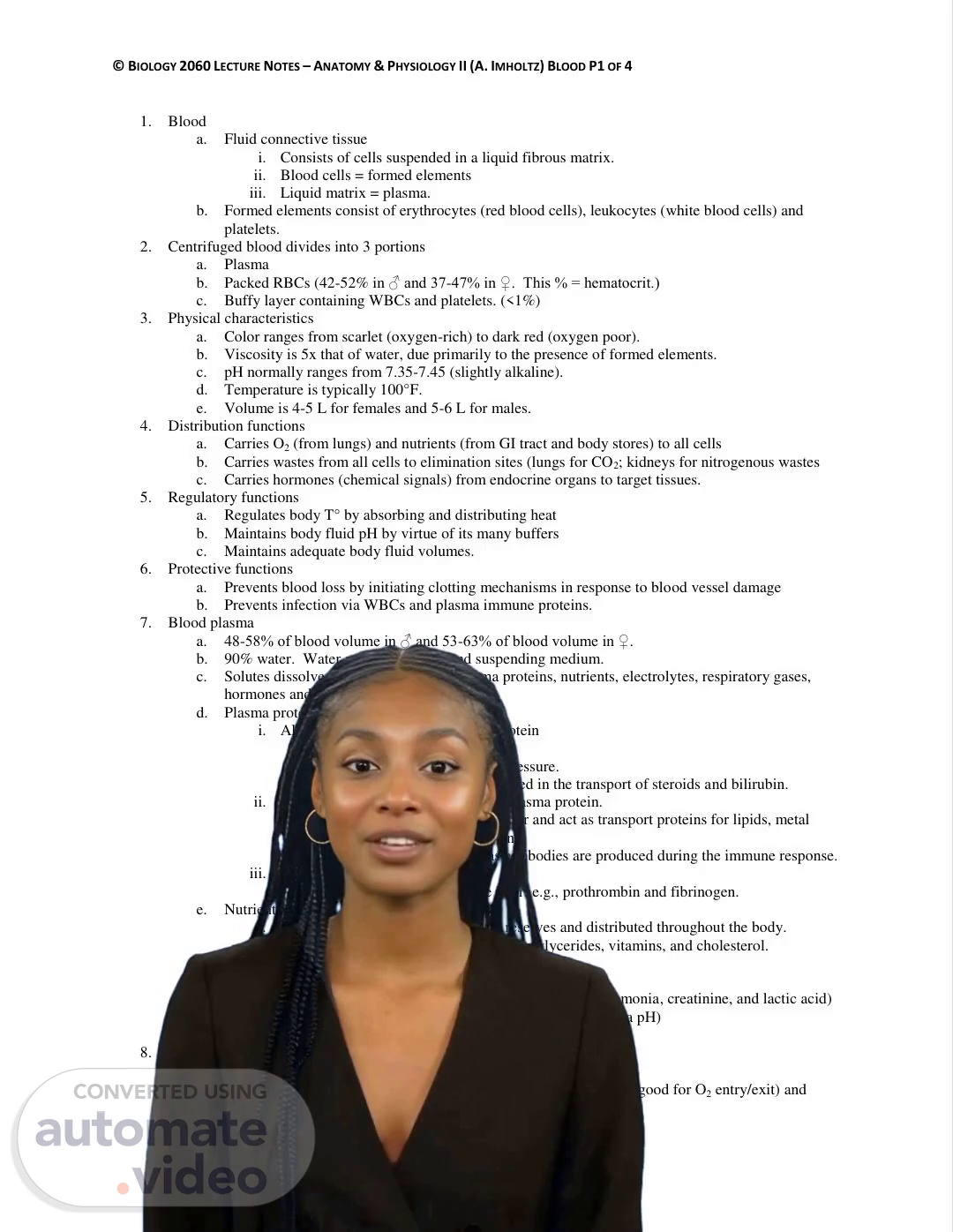Scene 1 (0s)
[Virtual Presenter] Blood is a vital fluid that plays an essential role in the human body. It is made up of cells and a liquid fibrous matrix known as plasma. The primary components of blood are blood cells which are also referred to as formed elements. These blood cells include erythrocytes (red blood cells) leukocytes (white blood cells) and platelets. When blood is centrifuged it is divided into three parts: plasma packed red blood cells and the buffy layer. Plasma is a crucial component of blood and contains proteins nutrients electrolytes respiratory gases hormones wastes and buffers. Red blood cells are the smallest cells in blood and are responsible for transporting oxygen. Thank you for your attention..
Scene 2 (49s)
[Audio] Blood is a vital connective tissue that carries oxygen nutrients waste hormones and electrolytes throughout the body. It is made up of various elements including red blood cells white blood cells platelets and plasma. Red blood cells also known as erythrocytes are formed without organelles and are stuffed with hemoglobin proteins. They play a primary role in oxygen transport and a minor role in carbon dioxide transport. Hemoglobin is abundant within red blood cells and binds and releases oxygen reversibly. Hemopoiesis also known as blood cell formation occurs in red bone marrow. All blood cells arise from a hemopoietic stem cell which is known as a hemocytoblast. Hemocytoblast divides and differentiates to form various types of blood cells including red blood cells. Erythropoiesis which is the formation of red blood cells requires iron and vitamin B-1-2--. The number of red blood cells in blood is remarkably constant and maintained via negative feedback. White blood cells also known as leukocytes are formed elements with nuclei and normal organelles. They protect the body from pathogens toxins and cancerous cells. White blood cells are formed in red bone marrow from hemocytoblasts. Platelets are formed elements that lack nuclei and organelles. They play a minor role in blood clotting and are responsible for stopping bleeding by forming a plug at the site of injury. Plasma is the liquid matrix of blood that carries oxygen nutrients waste hormones and electrolytes. It is composed of water proteins and other molecules. In conclusion blood is a complex connective tissue that plays a vital role in oxygen transport nutrient and waste removal and immune function. Its various elements work together to maintain homeostasis and support life-sustaining processes throughout the body..
Scene 3 (2m 49s)
[Audio] This slide discusses the immune response that occurs when blood cells leave the bloodstream and enter connective or lymphatic tissue. These cells are attracted to chemicals released by pathogens damaged cells or activated white blood cells (WBCs). Positive chemotaxis is the movement of these cells towards these chemicals. There are 5 main types of W-B-C-s-: neutrophils lymphocytes monocytes eosinophils and basophils. These cells are divided into 2 main classes: granulocytes and agranulocytes. Granulocytes contain membrane-bound granules that are dyed by Wright's stain while agranulocytes lack stainable granules. Granulocytes include neutrophils eosinophils and basophils all of which are spherical larger than red blood cells (RBCs) have lobed nuclei and stain specifically with Wright's stain. Agranulocytes include lymphocytes and monocytes. We will now discuss each of these 5 main types of W-B-Cs in more detail. Neutrophils are the most numerous circulating W-B-C making up 50-70% of the circulating W-B-C population. They contain fine lilac colored granules that take up acidic and basic dyes and have a nucleus consisting of 3-6 lobes (polymorphonuclear). Eosinophils make up 2-4% of the circulating W-B-C population and are bilobed in shape. They take up acidic dyes and their granules turn reddish orange. Eosinophils attack parasitic worms and engulf immune complexes involved in allergic reactions. Basophils are the least common of the 5 main types of W-B-C-s making up less than 1% of the circulating W-B-C population. They are bilobed in shape and take up acidic dyes. Basophils release histamine and other mediators of the allergic reaction when they encounter an allergen..
Scene 4 (4m 52s)
[Audio] The coagulation process is a critical process that helps to seal broken blood vessels and prevent excessive bleeding. This process consists of three stages: vascular spasm.
